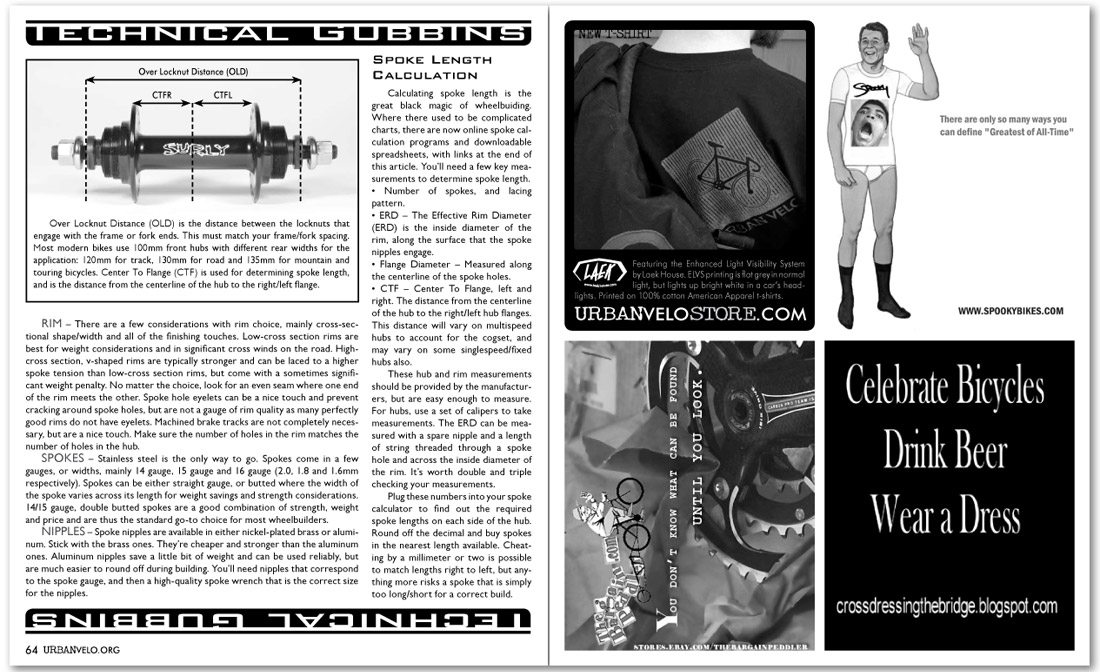| Wheelbuilding 101... Continued
Rim – There are a few considerations with rim choice, mainly cross-sectional shape/width and all of the finishing touches. Low-cross section rims are best for weight considerations and in significant cross winds on the road. High-cross section, v-shaped rims are typically stronger and can be laced to a higher spoke tension than low-cross section rims, but come with a sometimes significant weight penalty. No matter the choice, look for an even seam where one end of the rim meets the other. Spoke hole eyelets can be a nice touch and prevent cracking around spoke holes, but are not a gauge of rim quality as many perfectly good rims do not have eyelets. Machined brake tracks are not completely necessary, but are a nice touch. Make sure the number of holes in the rim matches the number of holes in the hub.
Spokes – Stainless steel is the only way to go. Spokes come in a few gauges, or widths, mainly 14 gauge, 15 gauge and 16 gauge (2.0, 1.8 and 1.6mm respectively). Spokes can be either straight gauge, or butted where the width of the spoke varies across its length for weight savings and strength considerations. 14/15 gauge, double butted spokes are a good combination of strength, weight and price and are thus the standard go-to choice for most wheelbuilders.
Nipples – Spoke nipples are available in either nickel-plated brass or aluminum. Stick with the brass ones. They’re cheaper and stronger than the aluminum ones. Aluminum nipples save a little bit of weight and can be used reliably, but are much easier to round off during building. You’ll need nipples that correspond to the spoke gauge, and then a high-quality spoke wrench that is the correct size for the nipples.
Spoke Length Calculation
Calculating spoke length is the great black magic of wheelbuiding. Where there used to be complicated charts, there are now online spoke calculation programs and downloadable spreadsheets, with links at the end of this article. You’ll need a few key measurements to determine spoke length.
• Number of spokes, and lacing pattern.
• ERD – The Effective Rim Diameter (ERD) is the inside diameter of the rim, along the surface that the spoke nipples engage.
• Flange Diameter – Measured along the centerline of the spoke holes.
• CTF – Center To Flange, left and right. The distance from the centerline of the hub to the right/left hub flanges. This distance will vary on multispeed hubs to account for the cogset, and may vary on some singlespeed/fixed hubs also.
These hub and rim measurements should be provided by the manufacturers, but are easy enough to measure. For hubs, use a set of calipers to take measurements. The ERD can be measured with a spare nipple and a length of string threaded through a spoke hole and across the inside diameter of the rim. It’s worth double and triple checking your measurements.
Plug these numbers into your spoke calculator to find out the required spoke lengths on each side of the hub. Round off the decimal and buy spokes in the nearest length available. Cheating by a millimeter or two is possible to match lengths right to left, but anything more risks a spoke that is simply too long/short for a correct build.
(continued)
|
|
|
|
|

